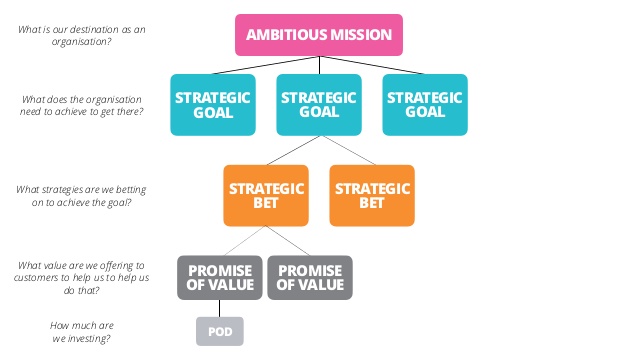Lean Value Tree
A simple tool to align people and initiatives across all levels of the business
Francisco Meza Guzman
Terence Brown
What Is Lean Value Tree?
The Lean Value Tree (LVT) is a conceptual tool to facilitate, share, and drive a company's strategy and vision across all levels and teams of an organization.
Why Do Lean Value Tree?
LVT is an enhancement to Lean Portfolio Management, uses a lean approach, encourages collaboration and is based in value delivery. It takes advantage of the visual work properties found in the Lean Portfolio and guides decisions and initiatives that tightly integrate with customer value and corporate vision, helping avoid initiatives that are time (and budget) wasting.
How to do Lean Value Tree?
The LVT follows a Top-Down framework: Vision > Strategic Goals > Bets > Initiatives. A company's vision is broken down into a number of strategic goals, which are then defined into a number of bets, out of which value streams and initiatives with specific, targeted outcomes drive achievement from the bottom up.

Goals
LVT goals should be strategic and ambitious, and must align with the company vision. These should focus on high-level outcomes rather than tactical goals specific solutions or outputs.
Bets
Each goal is broken down into a set of strategic bets. A bet is a value hypothesis that the organization believes can help achieve the goal with which the bet is associated with. If a bet does not function then it is taken out the tree, thereby assuring that time is not spent on something that is not achieving the corporate vision. The word "bet" is purposefully used as it forces a shift in mindset to use a VUCA methodology.
Initiatives
Initiatives define what should be done to test the value hypothesis of the associated bet. Typically they take the shape of one or more smaller hypotheses that clearly measure success. Through these initiatives, short term decisions can be made to determine if the hypothesis is approved or denied.
Initiatives are not projects. The difference between a project and an initiative is that the first one has a fixed deadline, while the other does not. Initiatives should be tested within a product backlog with constantly evolving hypotheses and re-prioritization until such time the value hypothesis of the overall initiative is proven or disproven.
It is important that the LVT be visible throughout the organization and be reviewed regularly by the Lean Portfolio Steering Committee. The continuous review of the Lean Portfolio makes it possible to remove, incorporate or correct initiatives, bets and goals.
Furthermore, the LVT should define individuals who are accountable and responsible for the implementation of the goals, bets and initiatives at every level, thereby creating diverse teams motiviated to achieve success.
Strategic vs BAU
While the Lean Value Tree focuses on strategic initiatives, a dilemma exists in all organizations is whether the LVT should be only used for strategic initiatives or whether Business As Usual (BAU) initiatives should be included as well (generally BAU initiatives fill 80-90% of the lean portfolio).
Focusing only on strategic initiatives allows for better execution of the strategic vision, however, excluding BAU initiatives may cause disharmony amongst those business units and could contribute to a lack of motiviation towards achieving any strategic initiatives.
Depending on the size of the organisation it may be worthwhile to include 100% of the lean portolio as long as the initiatives contribute to the strategic vision. This is generally feasible for small to medium organizations. In larger organizations, focus strategic or BAU initiatives at specific areas of the organization (such as strategic initiatives for the Executive team). Most importantly, the use of the LVT practice across the portfolio, whether it be strategic or BAU, ensure consistency in the approach of an organization's initiatives.
The Lean Value Tree is an great tool to manage the lean portfolio and could be the key to additional agile adaptability capacity within the organisation. It is also an excellent opportunity to engage digital transformation in collaboration with the Project Management Office (PMO), shifting the PMO's traditional focus in projects to bets with hypothesis using the LVT.
Further recommended reading: EDGE: Value-driven Digital Transformation by Jim Highsmith, Linda Luu and David Robinson.
Look at Lean Value Tree
Links we love
Check out these great links which can help you dive a little deeper into running the Lean Value Tree practice with your team, customers or stakeholders.
